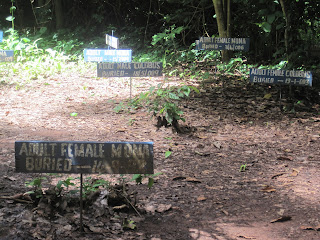May 16:
Today we went to Lake Bosumtwi or Crater Lake. It was our last day in Kumasi and a good way to finish out our stay there. This lake was formed by a meteorite in the late 1600s and is absolutely beautiful. The water is very warm and the surroundings are pretty amazing. I don't know if I have brought this up yet, but one of the best descriptions I have of Ghana would be "Lost", the TV show. Almost everywhere we go, multiple people in the group describe it as "Lost". In Mole we felt like we were staying in the colonies. At this lake the surroundings completely made me feel like I was on the show "Lost". I think part of the reason it feels like the show is because everything is completely foreign to us and we have to figure things out as we go. (If you haven't watched the show, I highly recommend it.)
One of our first views of the lake.
This man is fishing. There is Tilapia in this lake. The fisherman place nets in the water with plastic bottles tied to them to mark the spot of the net. They fish on these logs that are flat on the top and rounded on the bottom. There is no place to get inside, you just sit on the top and let your feet dangle in the water.
Farewell Kumasi, Hello Accra!


















































